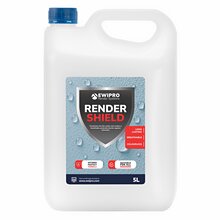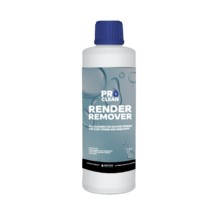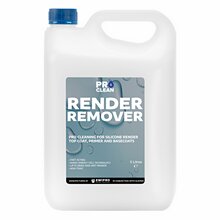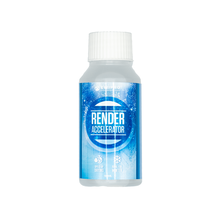Categories
Silicone Renders
Log in to save items on your shopping lists and access them on all your devices. Guest lists are deleted after 90 days.
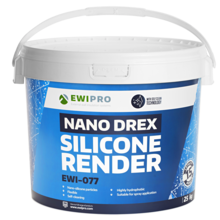
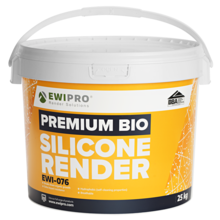
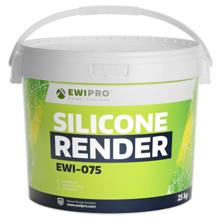
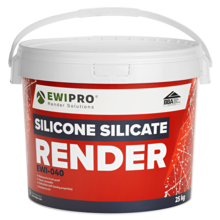
Silicone renders are flexible, fully breathable, and hydrophobic thin coat finishes for external render and external wall insulation systems. Using advanced silicone technology, these coloured render products deliver long term performance, aesthetic appeal, and enhanced protection on a wide range of substrates, including brick and existing render that is sound.
Our ready mixed, lightweight render range is stocked for fast dispatch. Choose popular Silicone Render EWI-075, premium bio options like EWI-076 Premium Bio Silicone Render, or hybrid Silicone Silicate EWI-040. Order samples from our samples range to compare colours and textures before you purchase.
Silicone renders: flexible, breathable and hydrophobic finish
Silicone thin coat render is specifically designed to create a smooth or fine texture finish that is completely water repellent in service while remaining vapour open. The hydrophobic properties shed rain and surface dirt, while greater flexibility helps resist hairline movement. As part of modern render systems, silicone enhanced formulas provide durable protection and a consistent silicone render finish.
What is silicone render and why choose it?
Silicone render is a polymer modified, ready mixed topcoat used as the final layer in the rendering process. Compared with traditional cement render and other types such as acrylic render, silicone offers crack resistance, water resistance, and breathability for long term performance. It is ideal for external render on homes and commercial properties, and it can be machine applied or spray applied to speed up plastering on large elevations. Explore our core silicone render products: EWI-075, EWI-076, and EWI-040.
Long lasting protection for external walls
Used over a reinforced base coat, silicone creates a protective surface that is lightweight, durable, and suitable for render-only projects or external wall insulation systems. The rendering method, grain size, and substrate preparation will vary depending on the property and materials, but the goal is the same: a breathable, water repellent coat that keeps the facade looking clean for years.
Key benefits of silicone rendering: is silicone render better than normal render?
Compared with sand and cement or other types of coat renders, silicone thin coat render delivers enhanced performance in flexibility, breathability, and water repellence. It is an ideal solution where you want a coloured render that resists staining and remains smooth and consistent over time. For value engineering, acrylic can be a cost effective alternative, but silicone is often the better choice for long term performance on exposed elevations.
Crack resistance and durability
Silicone formulations provide greater flexibility and crack resistance, reducing the risk of a silicone render crack as the building moves. When applied over a reinforced base with mesh, the system offers durable protection and a stable surface layer.
Breathable surface that helps prevent damp
Silicone render is fully breathable, allowing moisture to evaporate through the surface instead of trapping it in the wall. This helps manage damp risk in solid masonry and on properties that need vapour open finishes.
Hydrophobic properties for water protection
The hydrophobic surface is completely water repellent to rainfall, improving water resistance and helping the facade to stay cleaner for longer. This water repellent effect also supports long term performance in polluted or coastal areas.
Available in RAL, NCS or Pantone colours
Our silicone render products are available in an extensive range of colours and textures, from smooth to fine texture finishes. We can tint to RAL, NCS or Pantone so the coloured render matches your design without the need to paint later.
Choosing the right silicone render
Begin with the substrate and project goals. On difficult substrates or existing render that is sound, use the correct primer and reinforced base coat before applying your thin coat render. For render-only, Silicone EWI-075 is a versatile choice. For enhanced resistance to dirt, choose Premium Bio EWI-076. For a budget friendly silicone option, consider Silicone Silicate EWI-040. If you need an alternative finish, acrylic render remains popular on less exposed elevations.
Different types of render systems for different projects
Render systems vary depending on whether you are installing external wall insulation or completing a render-only refurbishment. For EWI, the typical build up is adhesive, insulation, base coat with mesh, primer, then silicone topcoat. For render-only on sound surfaces, apply base coat with mesh, primer, then the silicone top layer. Monocouche one coat renders are another option for thick coat applications; compare choices in our render systems hub.
Matching silicone render to your design needs
Select grain size for the required texture, choose machine applied or spray applied method for speed, and specify the colour to match adjacent materials. A silicone TC style grain of one to two millimetres gives a classic thin coat look that suits most homes. If you plan to refresh colour later, breathable silicone paint can be used on compatible systems.
Is silicone render expensive?
Silicone can be a more expensive option than cement render at the tub price, but the benefits often make it cost effective over time. Ready mixed product saves on mixing labour, the spray method reduces programme time, and the hydrophobic, breathable surface lowers maintenance. Product pages display prices with VAT added as well as ex VAT, so you can compare costs clearly.

